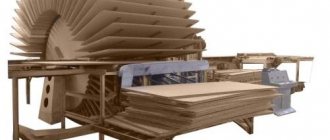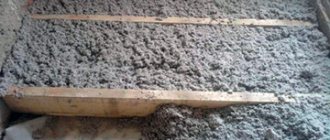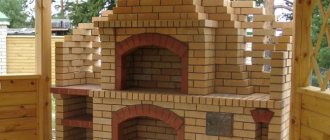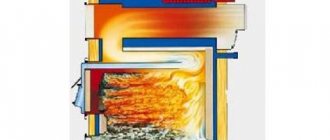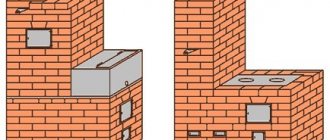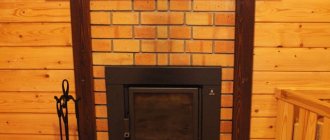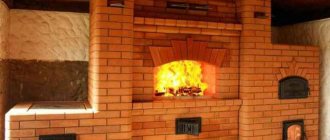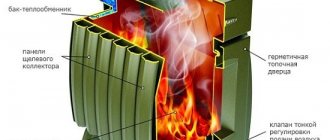Design and principle of operation
A stationary tandoor is a cylindrical clay oven, the neck of which is narrowed so that the structure resembles a large jug. But there are also designs in the form of a regular cylinder or shaped like a barrel. When both the top and bottom are narrowed.
As a rule, the stove is installed on a wide pedestal, and the structure itself has a blower at the bottom, which provides draft for burning the fuel. The latter can be charcoal, firewood or large brushwood. Its insertion is carried out through the neck. And in many models it is also necessary to remove ash through it.
In the classic design, a clay grill is surrounded in a circle with a brick frame. It can be round or square in shape. Thermal insulation material is distributed between the masonry and the outer walls of the furnace. In the old days, sand, salt or powdered clay were poured there. This helped keep the fireplace warm literally until the very end of the day. And they melted it in the morning.
Brick lining Source ideas.homechart.ru
Modern technologies make it possible to produce refractory materials of almost any shape. Yes, and such structures are used more for exotic things, instead of a regular barbecue. Just to pamper guests with original vertically cooked kebab and famous, delicious Uzbek flatbreads. And to do this, light the stove for a maximum of three hours.
Therefore, current tandoors are most often made only of brick, and structures in the form of a clay jug perform only mobile functions. But even a modern stove has thick enough walls to accumulate heat for a long time. And if the kindling is carried out correctly, the inner surface heats up to 400°C. Therefore, the tandoor device allows you to bake bread directly on the walls.
For convenience, the tandoor is equipped with various accessories. For example, a special holder for skewers. In this stove they are not stacked horizontally, but hang vertically inside the fireplace. There are also different grates on which you can bake vegetables or fish. True, it requires considerable experience and caution to handle them without getting burned. The fireplace with hot coals is covered with a lid on top.
Stationary tandoor Source postroika.biz
A distinctive feature of a tandoor from a regular barbecue is that food in it retains literally all its juices throughout the entire cooking process. Thanks to the tightness of the structure, a constant temperature is maintained and this does not allow the products to dry out. You can also cook and fry in a tandoor.
For this, special dishes are used. For example, a large cauldron with a rounded bottom and larger than the neck. It is installed on top, and it closes the oven like a lid. It makes delicious soups and roasts. Also a huge frying pan with the same bottom as a cauldron. Pilaf cooked on such a brazier is considered the most delicious in the world.
What is tandoor
A brick tandoor is a Turkish oven in which incredibly tasty kebabs are prepared. The secret of this is that the meat in this design is baked as evenly as possible. This effect is achieved due to the balanced distribution of heat. In the tandoor you can not only bake pork, veal and lamb, but also make delicious oriental flatbreads and pita bread. Let's take a closer look at how to make a tandoor with your own hands.
The traditional tandoor oven comes from Central Asia. It was made from refractory clay, dried in the sun and fired on saxaul wood. In mid-latitude conditions, it is almost impossible to reproduce such a technology, because drying clay requires special conditions:
- low humidity;
- a certain light spectrum.
The desert climate easily creates such a regime: the hot sun promotes the evaporation of moisture and heats the clay to 70 degrees, and the dust contained in the air acts as a kind of filter for UV rays. This allows the furnace to dry without internal stress, and during annealing it remains intact even with large wall thicknesses.
On clay that is dried under normal conditions, a crust quickly forms, but the inside remains moist. When they try to burn it, the internal moisture begins to escape sharply and cracks appear. Therefore, in our latitudes it will not be possible to make a ceramic tandoor, even if good fireclay clay is used.
Therefore, having decided to create such a structure at the dacha, folk craftsmen take its closest relative – the Armenian tandoor – as a basis. It is made of fireclay bricks, and its walls are much thicker, which allows it to retain heat for a long time.
The appearance of the stove resembles a clay jug. The fuel is placed directly inside and set on fire. When only coals remain from the wood, kebabs are placed inside the oven. They should be placed with the sharp end on the foundation or hung by a hook on a perch that is prepared in advance.
The undeniable advantage of the tandoor is its long-lasting heat retention. Thanks to this, you can prepare more than one batch of baked meat.
How does a tandoor oven work? At the bottom of this design there is a special hole called an inlet. The clay base is covered with bricks. A small air gap appears between the base and the brick, which is filled with sand or salt. Coal is placed inside through the top hole. There are also designs with a side hole, but in the traditional version this design is practically not used.
To make it more convenient to prepare barbecue, a special grill is provided. It is also used for fish and vegetables. Good heat-saving characteristics are due to the materials used to create the structure. All of them have phenomenal heat storage properties. The maximum temperature to which a brick oven can heat up is 400 degrees Celsius. If flat cakes are cooked in the oven, and not meat, then its walls are cleaned of ash and soot in advance.
Manufacturing technology
A competent approach to the construction of an oriental stove requires a project. The location is also pre-selected. It must meet the following conditions:
- Not located on a hill.
- Be away from any buildings.
- Do not be located in an area of high humidity.
If necessary, the area is leveled. It can also be refined if desired. For example, leave the tandoor itself in the open air, and next to it set up a table for food under a canopy.
Outdoor kitchen Source remontnik.ru
Preparation
Having a ready-made drawing, you can calculate the amount of materials needed. And in general, this way it will be clear what exactly is needed for construction. And since it is recommended to make a tandoor from fireclay bricks, you first need to prepare it. You will also need a special fireproof mixture for masonry.
Since there is no way to build a foundation, a sand-gravel mixture and cement are needed. A metal rod for reinforcement and a piece of asbestos pipe for the blower. You will also need steel wire to tie up the rows of masonry and a metal mesh with 5 cm cells if you decide to simply plaster the surface of the stove.
As for the tools, you need to take a standard set for a builder. You will also have to make a couple of devices yourself. And you will need a grinder with a diamond wheel for cutting bricks.
See also: Catalog of companies that specialize in the design and installation of fireplaces and stoves of any complexity
Foundation
Before building a furnace, the soil is carefully studied. If it is clayey, then a reinforced columnar foundation will be needed. In other cases, arranging a monolithic slab will be sufficient.
Foundation for tandoor Source ad-cd.net
Let's take a step-by-step look at how to do the latter:
- A hole is dug. For example, round. Its diameter should be half a meter larger than the size of the tandoor. Extra space will be needed for decorative finishing.
- The entire fertile layer is removed from the hole. The bottom is leveled and a simple formwork is installed, so that its top rises 10-15 cm above ground level. It is better to raise the base of the tandoor so that it is not washed away by precipitation.
- Waterproofing is laid on the bottom. A piece of ordinary roofing felt will do.
- Sand is poured into the pit to a thickness of at least 10 cm. A thin layer of crushed stone is laid on the sand cushion. The backfill is individually carefully compacted.
- A grid of reinforcement is placed on the crushed stone. And the formwork is filled to the brim with concrete mortar made in a ratio of 3:1:1. The first number refers to sand. The rest are for cement and gravel. The mixture is mixed with water until the consistency of thick sour cream.
- The surface is leveled, and its exact horizontalness is controlled using a building level.
Ready foundation Source yaplakal.com
The solution hardens within 72 hours. But before continuing work, it is necessary to let the structure stand for a total of 10 days. And so that the surface does not crack during summer construction, it is moistened with water every day.
Making fixtures
To work you will need a circle-shaped pattern. The easiest way to make it is from a piece of plywood. The circle should be the same diameter as the outer walls of the tandoor.
And you can’t do without a special rule. It is called a compass or a ballerina. It is impossible to line the neck of the oven without it. Therefore, a structure is assembled from wooden planks, which is shown in the figure below.
Template for building tandoor walls Source trizio.ru
When making it, you must be guided by the fact that the ratio of the neck to the base will be 1 to 3. That is, the uppermost spacer die should be exactly one third shorter than the lower part. For a flexible strap, you can take a strip of kragis.
Base
Although concrete is fire-resistant, it cannot withstand regular high heat. Therefore, it is necessary to lay the base of the furnace on the surface of the foundation. That is, its bottom.
Since fireclay bricks have already been selected for the tandoor, then they should also be used for the base. Moreover, you won’t find anything better than this variety. In addition to being fireproof, fireclay also easily withstands large temperature changes. And this allows you to operate the fireplace in winter, in frosty conditions.
Since the design of the stove is round, it is necessary to lay out the same base. There is a simple way to accomplish such a difficult task. On a separate flat surface, you need to lay out a square of brick, without connecting the elements with mortar. Then, using a previously made pattern, a circle is drawn on the plane.
Cutting bricks with a grinder Source legkovmeste.ru
Brick tandoor on a mobile platform
Basically, a mobile tandoor on a mobile platform would be an excellent choice.
Advantages:
- lighter and more compact option;
- easy to move;
- does not require foundation construction;
- does not require large costs for material.
Available tools are used as a mobile platform. An old wheeled frame from a trolley will do just fine.
Materials and calculations
We will need:
- fireclay brick;
a) internal contour
a = p*D = 3.14*0.8 m (according to external measurements) = 2.5 m
V1 brick = a*h*b = 2.5*1 m (with hwall = 1000 mm)*0.115 (masonry thickness) = 0.3 m3
b) outer contour
a = p*D = 3.14*1.23 m (according to external measurements) = 3.9 m
V2 brick = a*h*b = 3.9*1 m (with hwall = 1000 mm)*0.115 (masonry thickness) = 0.5 m3
c) bottom
S = a*b = 1.3*1.3*0.075 = 0.78 m2
V3 brick = a*h*b = 1.3*1.3*0.075 = 0.1 m3
Vbrick total = V1+V2+V3= 0.3+0.5+0.1 = 0.9 m3
Taking into account losses, we assume the brick consumption is 400 pcs. per 1 m3. Hence 400 pcs. *0.9 m3 = 360 bricks.
- basalt wool;
S = p*D * hwalls = 3.14*0.8 m (outside the internal contour) * 1 (with hwalls = 1000 mm) = 2.5 m2, rounded to 3 m2.
- ready-made fireproof mixture for masonry;
We assume a consumption of 470 kg per 1 m3 of masonry, from here
0.9*470 kg = 423 kg
- decorative stone for exterior decoration;
S = p*D * hwalls = 3.14*1.23 m (outside the internal contour) * 1 (with hwalls = 1000 mm) = 3.86 m2, rounded to 4 m2.
- various auxiliary materials - let's include here cutting wheels for a small grinder, a grinding wheel for concrete, rags, etc.
Tools
Standard list of tools:
- "Bulgarian";
- trowel;
- putty knife;
- wooden mallet;
- pliers, etc.;
- grinder.
Stages of work
Let's briefly look at the stages of work:
- preparing a mobile platform;
- marking contours, installing the sleeve;
- masonry of the internal contour;
- pug;
- drying;
- insulation;
- laying the outer contour;
- drying;
- hatch installation;
- decorative finishing;
- burning.
Step-by-step instruction
The schematic diagram of the device is similar to a large stationary stove.
However, there are the following differences:
- instead of a foundation - a wheelbase from a trolley;
- thinner walls;
- the design is smaller and lighter;
How to make a mobile tandoor from brick?
The procedure should be as follows:
- We fix a square or rectangular asbestos sheet, 10 mm thick, on the mobile platform. Size 1300x1300(1400) mm.
- We lay a continuous row of refractory bricks on the sheet. It will serve as the bottom. And prevent heat loss.
- We lay out the second row, leaving space for the blower.
- We use a piece of pipe Ø 820 mm as a metal clip. Length - 900 mm.
- We mark the order and prepare the first row of bricks. We process them on a grinding machine to obtain a circle of the required diameter.
- We are building. First, lay out the bricks dry. Then we put it on the solution.
- So we lay out 4 rows.
- We cover the tandoor with special circles for stoves (sold ready-made).
- We wrap the outside of the tandoor with basalt wool in 2 layers; previously, salt was enough.
- We lay out the outer contour of refractory bricks.
- During laying, coat the tandoor with clay inside and outside.
- We wrap the structure with a reinforcing mesh made of wire, 2-3 mm thick.
- We carry out external cladding with decorative stone.
- We dry and burn.
- You can start preparing aromatic shish kebab or meat.
Mobile brick tandoor
Other masonry options
To save consumables, some craftsmen use masonry - a vertical spoon. At the same time, the height of the stove also has 4 rows, but when building walls, the bricks are joined together not by a bed, but by a long side edge. But all technology remains unchanged. But it should be said that the strength of this design leaves much to be desired. Therefore, in this case, it is imperative to lay out the outer frame.
You can simplify the masonry process and make the stove in the shape of a strict cylinder. That is, do not make a neck at the end. At the same time, heat loss during cooking will increase, but not critically. And in this case, you can go two ways. Use a vertical poke in the masonry or place the brick horizontally.
Masonry from halves Source ad-cd.net
Decorative finishing
Before strengthening, insulating and decorating the tandoor, it is necessary to coat the internal walls with special clay. It is advisable to rub everything thoroughly and make a smooth surface. After the composition has completely dried, firing is carried out. The result is smooth, ceramic walls, on which bread is baked, sticking dough to them.
The remaining work will lead to an increase in the tandoor’s ability to accumulate heat. And the simplest is regular plastering. To do this, a metal mesh is fixed to the external walls. After this, the entire oven is coated with a thick layer of a special oven mixture. When the surface is completely dry, it is either covered with whitewash or painted with fireproof acrylic paint.
In the second way, a round oven turns into a square tandoor. To do this, a brick frame with right angles is laid around the cylinder. All voids between the walls of the fireplace and the external structure are filled with any heat insulator. Typically, all construction waste is used and supplemented with sand or slag. In this case, plaster is not done, but beautiful jointing is done on the masonry.
Decorative cladding of tandoor Source tildacdn.com
Earth tandoor
The first ovens were made in the ground. They can still often be found in the east. And the characteristics of an underground structure are even better than those of a furnace that is built on the surface.
When arranging a tandoor in the ground, it has some nuances:
- The diameter of the pit should exceed the external dimensions of the fireplace by 80 cm. This will be needed to fill the space with a heat insulator.
- The furnace walls are erected using any of the technologies described above. And you need to use the same fireclay brick.
- In the first row of masonry, above the laid base, an asbestos pipe must be installed, which reaches the surface at an angle of 45 degrees. It should have an adjustable damper.
- After coating the inner walls with clay mortar, they need to be allowed to stand for half a month.
- The firing process must last at least 180 minutes. In some cases it reaches up to 8 hours. When completed, the ideal surface produces a ringing sound when tapped.
When filling the void between the hearth and the ground, it is better to use crushed stone. All other materials do not resist frost swelling well. After careful compaction, the surface is either concreted or paving slabs are laid on it level with the neck.
Briefly about the main thing
If you want to build a magnificent oriental stove in your yard, you first need to decide on the design. Setting up a tandoor in the ground will be much easier. But it is more difficult to maintain. After all, after each use it is necessary to remove the ash, and this will have to be done lying down.
But with any choice, you need to purchase only fireclay bricks. Although there are other fireproof varieties that are half the price. Saving on the quality of the material will lead to the walls of the fireplace gradually beginning to collapse. Repairing a tandoor will not be cheap, and in the case of an earthen structure, it will be very difficult to carry out.
Ratings 0
Types of tandoor
The type of tandoor primarily depends on the location of its installation. Depending on this parameter, the following varieties are distinguished:
- pit tandoor,
- portable tandoor,
- ground tandoor.
We will consider the process of building a ground-based brick tandoor. The fact is that a pit tandoor is mainly used for heating rooms, and a portable one is a kind of variation of a regular barbecue.
